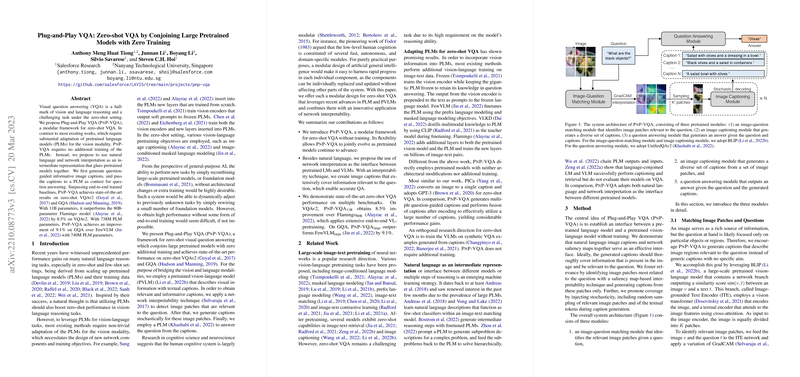Overview of "Plug-and-Play VQA: Zero-shot VQA by Conjoining Large Pretrained Models with Zero Training"
The paper presents an innovative framework called Plug-and-Play VQA (PnP-VQA), designed to address the challenge of visual question answering (VQA) in a zero-shot context. The key contribution of this work lies in its modular approach that leverages existing large pretrained models without additional training. This strategy stands in contrast to traditional methods that require substantial adaptation of pretrained LLMs (PLMs) for the vision modality, often involving architectural changes and new network components.
Key Methodologies
PnP-VQA employs a combination of large pretrained models to handle the vision and language reasoning tasks. The central idea is to use a pretrained vision-LLM (PVLM) to generate image captions that serve as a textual representation of visual input. These captions are guided by questions and aim to capture the most relevant information from the images.
The framework consists of three key modules:
- Image-Question Matching Module: Utilizes GradCAM to identify relevant image patches based on the input question. This step ensures that the generated captions focus on pertinent regions of the image.
- Image Captioning Module: Generates multiple diverse captions using the selected image patches. The stochastic generation process enhances coverage and diversity, increasing the probability of capturing relevant information.
- Question Answering Module: Relies on a pretrained LLM to derive answers from the generated captions. The framework uses a Fusion-in-Decoder method to efficiently process multiple captions, thus overcoming the input length constraints typical of encoder-based methods.
Performance and Results
PnP-VQA achieves state-of-the-art results in zero-shot VQA benchmarks such as VQAv2, OK-VQA, and GQA. Notably, with 11B parameters, PnP-VQA outperforms the Flamingo model (80B parameters) by 8.5% on VQAv2. The framework's success can be attributed to the effective use of modular components and the innovative application of GradCAM for patch selection.
Implications and Future Work
The implications of this research are significant for the development of flexible AI systems capable of handling multimodal tasks without retraining. PnP-VQA demonstrates that a modular, plug-and-play design can harness advances in individual model components for comprehensive task performance. This could be particularly impactful in scenarios requiring rapid integration of new models or adaptation to novel tasks.
Future developments could explore enhancing the interpretability and efficiency of such systems. The integration of additional modalities and the refinement of caption generation techniques might further improve performance. Additionally, mitigating inherent biases in pretrained models remains a critical area for ongoing research.
In conclusion, this paper exemplifies a paradigm shift towards modular, zero-training approaches in vision-language reasoning, showcasing the potential for significant advancements without the computational overhead associated with traditional training methods.
